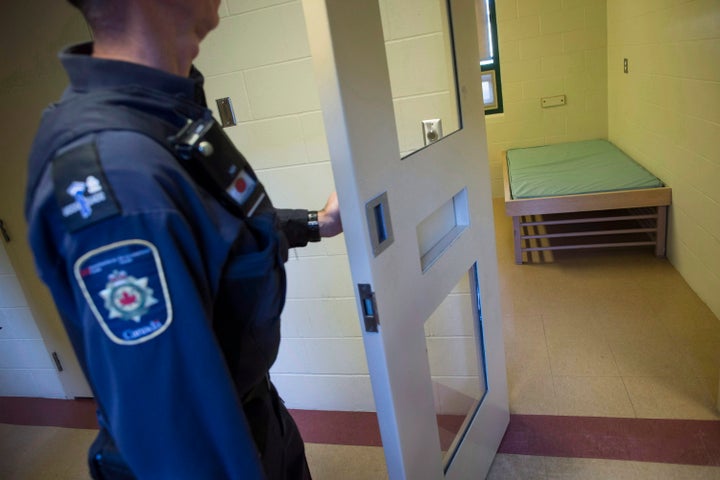
TORONTO — Prisons are one of the last institutions in Canada that have not seen a quick, co-ordinated response to stop the spread of the novel coronavirus, an extremely dangerous situation activists are demanding be addressed before it’s too late.
“My fear is there will be asymptomatic transmission [of COVID-19] and it will tear like wildfire through prisons,” Dr. Claire Bodkin, told HuffPost Canada, who has experience providing medical care in a Hamilton, Ont. jail and is part of a research team looking at prison health care.
“We need a co-ordinated national response to this, but instead it’s every institution doing its own thing and that’s not an acceptable standard of care.”
In Canada, there are on average 40,000 adults incarcerated in provincial jails or federal prisons every day, according to Statistics Canada. Inmates already have poorer health than the general Canadian population: research suggests they experience higher rates of tuberculosis, cardiovascular disease, asthma, diabetes and HIV, which makes them more vulnerable to COVID-19’s most severe symptoms of pneumonia and difficulty breathing.
A quarter of the federal prison population are 50 years old or older, also making them particularly at risk to COVID-19, reported the Office of the Correctional Investigator.
Watch: How American jails are preparing for COVID-19. Story continues below.
No inmates have yet tested positive for COVID-19, but activists say it’s only a matter of time. Ten inmates in Ontario have been tested, with five cases confirmed as negative, and five still pending, according to the Ministry of the Solicitor General.
In New York City, for example, COVID-19 is spreading through the infamous jail complex on Rikers Island, which sees a daily population of 7,000 inmates. On the weekend, at least 38 people were infected, according to media reports. Six prisons in Italy saw riots earlier this month after criminal trials were suspended and inmates were kept in overcrowded cells. Activists there say inmates have not been tested for COVID-19 so it’s impossible to say how many cases are in Italian jails.
The measures of social distancing and self-isolation recommended by Canadian public health officials are currently “not physically possible” for prisoners, said Martha Paynter, a Halifax nurse who advocates for and supports female inmates in provincial and federal institutions.

“People are just too close together,” she said. “Decreasing the prison population is the number one priority.”
And then they’ll need a place to go.
“Shelters and streets are not a solution,” Paynter said. “This needs pretty comprehensive support, especially with respect to housing and substance use treatment.”
Unlike public health care and emergency funding measures, the criminal justice system in Canada has not seen an intergovernmental, co-ordinated response to flatten the curve of the pandemic, wrote Canadian Civil Liberties Association (CCLA) executive director Michael Bryant in a letter to Attorney General of Canada David Lametti.
“In a nutshell, a public health approach would necessitate that the releasable be released; that detention be a measure of last resort,” Bryant wrote.
“Every release from confinement will alleviate overcrowding, avoid the spread of infection when the virus reaches penal institutions and protect inmates, correctional officers and innocent families and communities to which detainees and inmates will return.”

Bryant told HuffPost that given the pandemic restrictions on travel, many inmates should be deemed a low flight-risk and be released.
CCLA’s recommendations include co-ordination by the Attorney General of Canada to:
- Release inmates held in pre-trial custody and therefore presumed innocent by the legal system
- Where it’s not a threat to public safety, release people charged at the scene of an alleged offence instead of bringing them into custody
- Facilitate parole and probation hearings quickly over phone or video-conferencing
- Provide inmates with the option of having virtual visits and programming
- Consider conditional and compassionate releases.
CCLA has not received a response from the department, which also did not provide a comment for this story.
Correctional Service Canada said in a statement it is working closely with public health, and inmates who show symptoms of COVID-19 will be assessed and treated. It is also not allowing inmates out on temporary absences, unless it's medically necessary.
The union representing federal correctional officers is asking they all be tested for COVID-19, regardless if they show symptoms, to verify if they’re infected “or more importantly if they’re not,” said Jeff Wilkins, national president of the Union of Canadian Correctional Officers.
“Our work is inherently dangerous,” said Wilkins, a veteran correctional officer in Nova Scotia. “Our members go to work with a heightened sense of anxiety everyday. COVID-19 only further exacerbates that.”
Each province has taken a varied and often slow approach to reduce the number of prisoners during the pandemic, and stop COVID-19 from spreading in jails, resulting in a patchwork of responses.
B.C. has restricted provincial jail visits, is allowing only essential services like supply and mail deliveries to continue, and is encouraging lawyers to talk to their clients over the phone, according to the Ministry of Public Safety. It’s also planning to isolate all new inmates until it is clear they don’t have symptoms.
Alberta inmates serving weekend sentences will instead do so under house arrest, said the Justice and Solicitor General department. The province is also reviewing non-violent inmates who have a low-risk of re-offending, to determine if they should be temporarily released, as per a long-time policy that allows discretion for those with a medical need.
All provincial detention centres — including for youth — have also made changes to “out of cell” time to balance with social distancing.
Quebec and Ontario have both paused weekend sentences.
“Inmates who show symptoms or who have returned from travel within the past 14 days are placed in segregation and followed up by the health-care service of the detention facility,” said Quebec’s Minister of Public Safety spokesperson Marie-Josée Montminy.
Watch: What is social distancing? Story continues below.
Last Friday, Ontario’s Solicitor General Sylvia Jones also granted correctional services permission to grant early release to inmates near the end of their sentences, and who are considered a low risk to re-offend.
These measures came after a correctional officer at the Toronto South Detention Centre tested positive for COVID-19. The provincially run jail is Canada’s second largest facility of its kind, and already experiences overcrowding, chronic staffing shortages and frequent lockdowns.
The correctional officer had returned from a trip to Europe and, with no immediate symptoms, reported to work, a source working in Toronto South told HuffPost Canada. At that time, an employee was required to flag to superiors if they had symptoms. The source spoke on the condition of anonymity as he is not authorized to speak publicly.

Last Friday, the province changed the policy, instructing all guards who had travelled outside Canada to self-isolate for 14 days, regardless of whether or not they showed symptoms.
Professionals, such as lawyers, are still allowed to visit Toronto South, although personal and volunteer visits are suspended, according to a memo seen by HuffPost. Only guards admitting and discharging inmates are to wear masks and eye protection, but it’s “not a general requirement for all staff,” the memo said.
The source said even with bail being offered more widely and about 150 to 250 weekend sentences on hold, Toronto South is still housing about 1,050 inmates. Its capacity is 1,650.
“The hardest part is coaching inmates on how to clean with soap and water regularly. They all want disinfectant wipes and hand sanitizer, but we’re already almost out,” the source said.